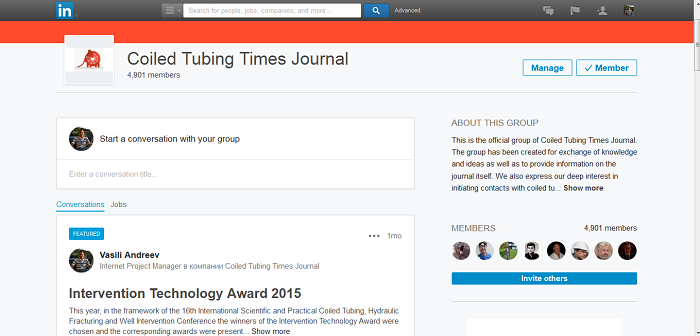- Home page /
- Journal /
- CTTimes in social media /
- N2 Pumping through Coiled Tubing
N2 Pumping through Coiled Tubing
Let’s remind that scientific and practical Coiled Tubing Times Journal is an active member of social networks. In particular, the journal has its own page on Twitter (https://twitter.com/cttimesdotorg), a widely known social network that enables users to send and read short messages. On that page one is always able to find links to the most up-to-date news of oil and gas industry and oilfield services. Such an option will be very useful for our readers who often use mobile phones and tablets for surfing the web and accessing the Twitter via a specialized mobile application.
Coiled Tubing Times has its own group on LinkedIn website. LinkedIn is a business-oriented social networking service which allows establishing professional relationships. More than 225 millions of users representing 150 industry segments from 200 countries are registered in the service. The group of our journal (https://www.linkedin.com/groups/2244679) is actively developing and growing in a number of participants. Almost 4,900 users from Russia, USA, Canada, Middle East, Latin America and Asia-Pacific region are currently registered as the members of our group.
LinkedIn social networking service allows not only to establish business contacts and find new friends, but also to find answers to the questions you are interested in. A large number of professionals working in oil and gas industry in general and coiled tubing industry, in particular, are the members of our group. You can always count on that your questions will find the proper answers, and you’ll get the information that will be useful for you.
Coiled Tubing Times continues to publish some of the most interesting and lively discussions started in the Coiled Tubing Times group on LinkedIn. One of such discussions is introduced below.
Saqib Jah Temuri, Technical Engineer at Sprint Oil & Gas Services, asks: “I have a query regarding maximum allowable N2 pumping rate through coiled tubing (CT). If it is related with erosional velocity of CT, what is the maximum N2 pumping rate allowed for HS80 CT?”
Abdul Sattar Bugti: “This depends on the well depth and weight of the fluid.”
Rafis Sharipov: “Do you want to pump only N2? What is the purity of your liquid nitrogen? If it is 99.9%, we can forget about erosional velocity. And sure, rate depends on CT size, well design, and pumping pressure.”
Abdul Sattar Bugti: “Rafis, you are right.”
Saqib Jah Temuri: “Rafis, let’s suppose that we are pumping only 99.9% N2. Can we increase N2 rate to as high as safe burst pressure limitations of CT at surface?”
David Cook: “Saqib, yes. Though if you are circulating, then special engineering consideration needs to be taken.”
Abdul Sattar Bugti: “N2 pumping depends on wellbore operational requirements. In normal acid stimulation pumping acid nitrified rate is 350-450 scf/min, while in simple well kick-off operation 350-400 scf/min N2 rate will be suitable. But after tagging Kick-off Depth (KOD) station, start pumping 500-700 scf/min till wellbore acid or water is offloaded.”
Saqib Jah Temuri: “Abdul, N2 rate during stimulation and kickoff operations depends on various factors, it’s not limited to just 500-700 scf/min. You can increase it to even 1500-2000 scf/min.”
Rafis Sharipov: “Yep. I pumped 2000 scf/min through 1.75” CT about two months ago.”
Perhaps, comments of these specialists will be useful for the readers of our journal.
By Vasili Andreev, Coiled Tubing Times
Note. The opinions of the above specialists do not necessarily represent the opinion of the Editorial Board.
-
12.10.2022
23th International Scientific and Practical Coiled Tubing, Hydraulic Fracturing and Well Intervention Conference
-
16.09.2022
Exec: Gazprom plans to keep investment program for 5 years
-
24.12.2021
Gazprom Neft, Skoltech and the Khanty-Mansi autonomous okrug-Yugra are developing technologies to produce hard-to-recover oil
-
17.12.2021
Gazprom neft establishes Russia’s first test facilities for developing hard-to-recover oil production technologies


